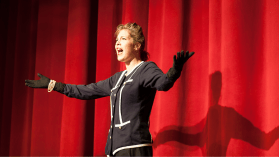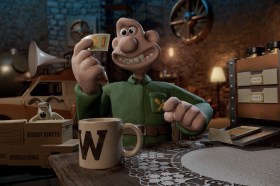Stunt coordinator Philli Anderson has worked with such actors as Dame Helen Mirren, Asher Keddie, Teresa Palmer and Noomi Rapace, among others, as a stunt double. While the UK-born specialist started her career as a gymnast (not to mention a period on the British Freerunning team), she turned to the performing arts before moving to Australia and establishing her career in the stunt industry.
With a kit of skills including acrobatics, marital arts and aerials, combined with theatre skills, she has worked on screen and television, from blockbuster movies such as Harry Potter, Clickbait (2021), Ride Like A Girl (2019) and Fast and Furious 9 (2021) – where she was lead stunt coordinator – to advertising campaigns for Adidas and Reebok, and live performances for the English National Opera.
But it didn’t all start with stars and Hollywood. Anderson speaks about how she got her start in 2009, and was the first woman to break into the industry in Australia.
Most recently, Anderson performed on the film The Fall Guy, which was shot in Sydney with actor Ryan Gosling, and has just finished working on the ABC/CBS production of Gold Diggers and Disney+’s The Clearing. She also delivered the lecture ‘Danger is my Business: Working with Practical FX‘, for St Kilda Film Festival (1-12 June 2023).
How would you describe what you do to a non-arts friend?
As a stunt coordinator I have to read a script and bring the action elements to life, both safely and in line with the director’s vision. We tell the exciting parts of the story without distracting from the narrative, so that you think of a piece of action as a whole. I have to work out how we are going to do it, what I need to do to make it happen, who I need to help me to make it happen – and then I have to make it work in reality.
What qualifications do you need to be a stunt coordinator?
The Stunt Department is one of the only departments on set that has a formal qualification process. To become a stunt coordinator you first need to have extensive experience as a stunt performer. To gain your ‘stunt licence’ you need to qualify in four out of five categories and attend stunt training with graded professionals. These categories are: vehicles, fighting or flipping, heights, water work or animals. You then apply through the National Stunt Grading Committee, and are approved to work.
This system protects the safety of the performers, actors and onlooking crew. Unfortunately, you can’t just rock up on set to ‘give it a go’ for very obvious reasons. Once you have your training stripes, it can take anywhere between 10 and 20 years to become a stunt coordinator.
How did you get your start in this career?
I grew up in the UK with a background in both gymnastics and theatre. I was working in live performance on a cruise ship and saw a video of Australia. Melbourne became my next stop. When I arrived, I quickly immersed myself in stunt training. I remember having to be interviewed by my first stunt coordinator before he let me join training. I told him that one day I would be the best, and he replied with a very curt, ‘We’ll see.’
Since then, I have been fully embraced by the industry and I have gone on a whirlwind journey. I have had a great mentor who has seen me through the past 10 years of my career, and my colleagues have become like brothers to me. Gaining the trust and respect of my peers has allowed me to have a long and crazy career.
Read: So you want my arts job: Cruise Entertainer
How collaborative is this job?
This is a job where you really rely on your peers at times to save your life. They may be holding the end of the rope as you jump across a building or using a fire extinguisher to put you out after you are alight. I am not sure you can get more collaborative than that!
In addition, as a stunt coordinator you are involved in the creative process of bringing the story from the page to reality. This is not possible without collaborating, not only with other creatives to give the director what they are seeking, but almost every other department as well.
We interact greatly with the art department (AD) and locations to ensure we can accommodate our safety requirements and to ensure we have enough time allocated for our work, with HMU (hair and make-up) to ensure we provide appropriate doubles and with wardrobe to discuss padding. We interact with continuity when we use our doubles, with the camera team to ensure our angles work for the shot, with the vehicles department, and the production office to schedule rehearsals and ensure relevant information is communicated to all.
What’s an average week like?
There is no such thing as an average week in the Stunt Department. The scope of what we do is so vast that ‘normal’ does not appear in our vocabulary. The week is very project dependent. A lot of our work is done in the preparation stage. This may be in physically assessing and preparing actors, designing the sequences with the stunt team, or systematically rehearsing bigger stunts and filming a previs (previsualisation) to demonstrate what will happen onset.
Once we reach the shooting stage, our preparation work will be done and shared. When the cameras are rolling, this may be in the water, in the air, in a vehicle or in a very small studio space, which we are not allowed to destroy! We may have a team of two, or we may have a team of 30. The one thing that I can tell you, is that we will be having fun and keeping our friends safe while we are doing it.
What’s the most common misconception about your job?
That it is glamorous! Invariably we will be wet, cold, muddy, sweaty, tired, sore … and not complaining. The second biggest misconception is that we are reckless and fearless. We take huge risks in our job, but they are all calculated and safety is of the utmost importance. There is no room for complacency, panic or daredevil type behaviour. I have trained my body and mind to ensure I can perform safely.
Now as a stunt coordinator, it is my job to know when actors and/or performers are hesitant, and to put the relevant steps in place to ensure that they are confident in what they are doing, and that they have been prepared properly.
How competitive is this job?
The stunt industry does not always follow a linear path. Each performer, and to some extent coordinator, has a unique skill set. It is up to them to identify what their skill set is and to build it to the level that they want. Then it is a little down to ‘the luck of the draw’.
If you specialise in horses and a horse movie comes to town, you are very likely to be employed. Similarly, if they make a fight-heavy film here and you are a fighter you have more of a chance of getting work. The best way to make yourself as employable as you can, is to work your speciality, but to also be an all-rounder. Of course this takes more training, but it gives more reward.
In an interview for your job, what skills or qualities would you be looking for?
To become a stunt coordinator you have to have been immersed in the industry for many years and be recommended by your peers on merit. When I am looking to help trainees or to hire stunt people, I look at their skill, but I also look for respectful team players who have a strong personality and are willing to learn. As well as being physically capable, I want to know that you are not afraid to muck in, and that I can send you on a task and know it will be completed professionally. I love people asking questions, and hope that every person learns something every time we go to work. I know I certainly still do.
What’s changing in the stunt profession today?
The quality of work that is being produced has increased dramatically and it is important to keep up with this expectation. Streaming services are producing TV series with feature film quality. Generally, they still have a television schedule and budget, and the challenge is to provide the quality that is expected without compromising your team or the conditions that we have worked so hard for.
What’s the weirdest thing that’s happened to you in this job?
I could write an essay here. There are so many pinch-myself stories that I have to remind myself that someone pays me to do what I do. From lying in a harness in the middle of the Thai jungle watching the locals chop down palm tree fronds in a single cut, to having to slap my cheeks to focus before I drove a car off a cliff because there was a pod of whales swimming past – I feel so fortunate to be able to have had so many experiences.
But they are not all positive. Recently during a long drone shot I was lying in a bush in the middle of the Nullarbor to look after an actor and there was a freshly shed snakeskin directly in front of me. I could not wait for the word ‘cut’ or run out of there fast enough.
What about gender balance and diversity in your industry?
In 2021 I was the first female stunt coordinator to become qualified in Australia. We now have four who are qualified and doing great work around the world. We also have a very strong female contingent coming through, both as performers and assistant coordinators.
In an industry where we really do become family, and trust is key, I would like to think that in the more senior roles, gender is irrelevant and that our success is based upon our creativity and its output. I was supported greatly by my stunt brothers.
Diversity is more of a challenge and one that we are continuing to develop. We are fully willing to support more diversity in the stunt community.





